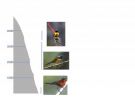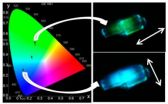(Press-News.org) SAN DIEGO (April 30, 2014) – New analysis of data from the 2003-2010 What We Eat In America (WWEIA) National Health and Nutrition Examination Survey (NHANES), a program of the Centers for Disease Control and Prevention (CDC), indicates that consumers of frozen meals (1) compared to consumers of quick service restaurant (QSR) meals (2) had lower calorie intakes and better Healthy Eating Index (HEI) score. In fact, the analysis revealed that those who consumed frozen meals consumed 253 fewer calories than those who consumed a quick service restaurant meal.
These results were presented at a scientific poster session at the Experimental Biology Conference (EB) April 26-30, 2014.
"The analysis shows consumers of frozen meals come a little closer to meeting Dietary Guidelines for Americans than consumers of quick service restaurant meals, and they do it with 253 fewer calories a day," said Dr. Victor L. Fulgoni, co-author of the analysis and vice president of Nutrition Impact, LLC.
Specifically, the analysis revealed that those who consumed frozen meals, when compared to those who consumed QSR meals, had significantly:
lower calorie intake (2073±51 kcal/d frozen meal consumers vs 2326±20 QSR consumers)
higher total Healthy Eating Index (HEI) score (53.0±1.5 frozen meal consumers vs 44.4±0.4 QSR consumers)
higher intakes of total vegetables (3.4±0.1 frozen meal consumers vs 2.9±0.03 QSR consumers)
higher intakes of greens and beans (1.7±0.2 frozen meal consumers vs 0.9±0.04 QSR consumers)
higher intakes of whole grains (2.9±0.3 frozen meal consumers vs 1.8±0.1 QSR consumers)
higher intakes of total protein foods (4.4±0.1 frozen meal consumers vs 4.1±0.03 QSR consumers)
lower intakes of refined grains (6.6±0.4 frozen meal consumers vs 5.4±0.1 QSR consumers)
lower intakes of empty calories (13.1±0.5 frozen meal consumers vs 9.9±0.2 QSR consumers)
"We are excited about the results of this study as it shows that frozen meals can play an important role in helping Americans meet the US Dietary Guidelines," said Kim Krumhar, Ph.D., Scientific Advisor – Nutrition, Nestlé.
The Healthy Eating Index (HEI) is a benchmark to evaluate the quality of calories consumed, and is recognized as a measure of diet quality in terms of conformance to Federal dietary guidance. It is used to monitor the quality of American diets; to examine relationships between diet and health-related outcomes and between diet cost and diet quality; to determine the effectiveness of nutrition intervention programs; and to assess the quality of food assistance packages, menus, and the U.S. food supply. More information about HEI is available at http://www.cnpp.usda.gov/HealthyEatingIndex.htm.
As the world's leading nutrition, health and wellness company, Nestlé is committed to working with nutrition, health and wellness professionals to help consumers enjoy meals they love while also meeting US Dietary Guidelines. Balance Your Plate with Nestlé is an educational program that highlights the important role frozen prepared foods can play in helping Americans meet US Dietary Guidelines and MyPlate recommendations for healthy eating patterns. Frozen, ready-made entrées are a source of pride for Nestlé. They are freshly made and simply frozen. Nestlé cooks prepare a wide variety of frozen dishes with care, making key ingredients – like pasta for our iconic lasagna or macaroni and cheese – from scratch. Then the food is frozen to help lock in nutrients and provide convenience for easy enjoyment at home or at work. The company also works continually to improve the nutritional profiles of its products by featuring positive nutrients such as whole grains, calcium, Omega-3s and antioxidants and by reducing nutrients like fat and sodium.
INFORMATION:
The study was supported by Nestlé USA. For more information and links to the Experimental Biology scientific abstracts please visit http://experimentalbiology.org/2014/Program-Information/Society-Programs.aspx
About Experimental Biology
Experimental Biology (EB) is an annual conference organized by six scientific societies. This meeting brings together the leading researchers from dozens of life-science disciplines. The societies represented at the meeting will be: the American Association of Anatomists (AAA), the American Physiological Society (APS), the American Society for Biochemistry and Molecular Biology (ASBMB), the American Society for Investigative Pathology (ASIP), the American Society for Nutrition (ASN) and the American Society for Pharmacology and Experimental Therapeutics (ASPET).
(1) Defined consumption of any of 91 specific frozen meals
(2) Defined as obtaining meals from "restaurant fast food/pizza"
Frozen meal eaters get more vegetables including greens, beans and whole grains but with lower total calories vs. fast food restaurant eaters
Data unveiled at 2014 Experimental Biology Conference in San Diego, April 26-30
2014-04-30
ELSE PRESS RELEASES FROM THIS DATE:
Competition for ecological niches limits the formation of new species
2014-04-30
The rate at which new species evolve is limited by competition for ecological niches, report scientists from the University of Chicago in Nature on April 30. The study, which analyzes the evolutionary and genetic relationships between all 461 songbird species that live in the Himalayan mountains, suggests that as ecological niches within an environment are filled, the formation of new species slows or even stops.
To study what controls the process of speciation, Trevor Price, PhD, professor of ecology and evolution at the University of Chicago, Dhananjai Mohan of the ...
Initial research: Mango's effects on ulcerative colitis & bone parameters in animal models
2014-04-30
SAN DIEGO, CA – April 30, 2014 – Three new mango-related studies were presented this week at the 2014 Federation of American Societies for Experimental Biology (FASEB) in San Diego, revealing initial findings on the effects of mango consumption on ulcerative colitis and bone parameters in animal models.
"The mango industry's nutrition research program is committed to advancing our understanding of the role mangos can play as part of a healthy diet," said Megan McKenna, Director of Marketing for the National Mango Board. "These studies provide important insights that ...
Multiple consecutive days of tornado activity spawn worst events
2014-04-30
WEST LAFAYETTE, Ind. - Significant tornado outbreaks and especially strong tornadoes are more likely occur within periods of activity lasting three or more days, according to a Purdue University tornado expert.
Jeff Trapp, a professor of earth, atmospheric and planetary sciences, examined 30 years of U.S. weather records and found that an outbreak of 20 or more reported tornadoes had a 74 percent probability of occurring during a period of tornado activity lasting three or more days. During those same periods, a tornado rated 3 or higher on the Enhanced Fujita scale had ...
MS researchers find brain & cognitive reserve protect long-term against cognitive decline
2014-04-30
West Orange, NJ. April 30, 2014. Multiple sclerosis researchers have found that brain reserve and cognitive reserve confer a long-term protective effect against cognitive decline: Sumowski JF, Rocca MA, Leavitt VM, Dackovic J, Mesaros S, Drulovic J, Deluca J, Filippi M. Brain reserve and cognitive reserve protect against cognitive decline over 4.5 years in MS. Neurology. 2014 Apr 18. doi: 10.1212/WNL.0000000000000433 [Epub ahead of print]. James Sumowski, PhD, lead author of the article, and John DeLuca, PhD, are at Kessler Foundation. Co-authors are from the Manhattan ...
'US Should significantly reduce rate of incarceration,' says new report
2014-04-30
WASHINGTON -- Given the minimal impact of long prison sentences on crime prevention and the negative social consequences and burdensome financial costs of U.S. incarceration rates, which have more than quadrupled in the last four decades, the nation should revise current criminal justice policies to significantly reduce imprisonment rates, says a new report from the National Research Council.
A comprehensive review of data led the committee that wrote the report to conclude that the costs of the current rate of incarceration outweigh the benefits. The committee recommended ...
Seeing the bedrock through the trees
2014-04-30
University of California, Berkeley, geologist William Dietrich pioneered the application of airborne LIDAR – light detection and ranging – to map mountainous terrain, stripping away the vegetation to see the underlying ground surface.
But that didn't take him deep enough. He still couldn't see what was under the surface: the depth of the soil, the underlying weathered rock and the deep bedrock.
He and geology graduate student Daniella Rempe have now proposed a method to determine these underground details without drilling, potentially providing a more precise way to ...
Hope for better drugs to treat stroke and heart attacks
2014-04-30
An international team of researchers in cooperation with the University of Bonn has taken two "snapshots" of a receptor which are of critical importance for blood coagulation. The scientists now hope to be able to develop novel drugs using these results. These include tailor-made blood-thinning substances for heart attack and stroke patients whose effects are reversible and better controllable than those of current therapies. The researchers are presenting their results in the renowned journal "Nature."
After a cut to the finger, blood platelets come into play: they adhere ...
Should the EU ban on the import of seal products stand?
2014-04-30
Next month, following an appeal by Canada and Norway to overturn the EU ban on the import of seal products, the World Trade Organization (WTO) is expected to announce whether the 2013 decision will be upheld. In an editorial article, a University of Bristol academic, whose research on the animal welfare of the seal hunt has been used in the case, explains why the ban should stand.
The article by Dr Andy Butterworth, Senior Lecturer in Animal Sciences at the University of Bristol's School of Veterinary Sciences and an official observer of the seal hunt is published in ...
Prostate cancer and blood lipids share genetic links
2014-04-30
Numerous studies have suggested a relationship between cardiovascular disease risk factors and prostate cancer. A new study by researchers at the University of California, San Diego School of Medicine, with colleagues in Norway, significantly refines the association, highlighting genetic risk factors associated with low density lipoprotein (LDL) cholesterol and triglycerides as key players and identifying 17 related gene loci that make risk contributions to levels of these blood lipids and to prostate cancer
The findings, published in the April 30, 2014 online issue of ...
New hybrid material that changes colour according to the direction of the light
2014-04-30
This news release is available in Spanish. The aim with respect to hybrid materials with one organic component and another inorganic one is to combine the best attributes of each one into a single system. Labs across the world are working to develop new hybrid materials for technological applications in nanotechnologies, in particular, and these materials are already being used in lightweight materials for cars, sports equipment, in biomimetic materials, like prostheses, etc.
The hybrid material being sought after by the research group in the Department of Physical ...
LAST 30 PRESS RELEASES:
Making lighter work of calculating fluid and heat flow
Normalizing blood sugar can halve heart attack risk
Lowering blood sugar cuts heart attack risk in people with prediabetes
Study links genetic variants to risk of blinding eye disease in premature infants
Non-opioid ‘pain sponge’ therapy halts cartilage degeneration and relieves chronic pain
AI can pick up cultural values by mimicking how kids learn
China’s ecological redlines offer fast track to 30 x 30 global conservation goal
Invisible indoor threats: emerging household contaminants and their growing risks to human health
Adding antibody treatment to chemo boosts outcomes for children with rare cancer
Germline pathogenic variants among women without a history of breast cancer
Tanning beds triple melanoma risk, potentially causing broad DNA damage
Unique bond identified as key to viral infection speed
Indoor tanning makes youthful skin much older on a genetic level
Mouse model sheds new light on the causes and potential solutions to human GI problems linked to muscular dystrophy
The Journal of Nuclear Medicine ahead-of-print tip sheet: December 12, 2025
Smarter tools for peering into the microscopic world
Applications open for funding to conduct research in the Kinsey Institute archives
Global measure underestimates the severity of food insecurity
Child survivors of critical illness are missing out on timely follow up care
Risk-based vs annual breast cancer screening / the WISDOM randomized clinical trial
University of Toronto launches Electric Vehicle Innovation Ontario to accelerate advanced EV technologies and build Canada’s innovation advantage
Early relapse predicts poor outcomes in aggressive blood cancer
American College of Lifestyle Medicine applauds two CMS models aligned with lifestyle medicine practice and reimbursement
Clinical trial finds cannabis use not a barrier to quitting nicotine vaping
Supplemental nutrition assistance program policies and food insecurity
Switching immune cells to “night mode” could limit damage after a heart attack, study suggests
URI-based Global RIghts Project report spotlights continued troubling trends in worldwide inhumane treatment
Neutrophils are less aggressive at night, explaining why nighttime heart attacks cause less damage than daytime events
Menopausal hormone therapy may not pose breast cancer risk for women with BRCA mutations
Mobile health tool may improve quality of life for adolescent and young adult breast cancer survivors
[Press-News.org] Frozen meal eaters get more vegetables including greens, beans and whole grains but with lower total calories vs. fast food restaurant eatersData unveiled at 2014 Experimental Biology Conference in San Diego, April 26-30



